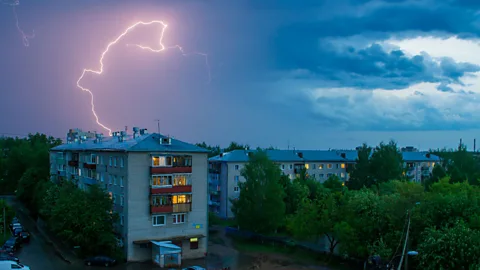What it’s like to be struck by lightning
 Getty Images
Getty ImagesFor every 10 people hit by lightning, nine will survive. What happens to the body when a bolt strikes, and how likely is it to happen? Charlotte Huff investigates.
Sometimes they’ll keep the clothing, the strips of shirt or trousers that weren’t cut away and discarded by the doctors and nurses. They’ll tell and retell their story at family gatherings and online, sharing pictures and news reports of survivals like their own or far bigger tragedies. The video of a tourist hit on a Brazilian beach or the Texan struck dead while out running. The 65 people killed during four stormy days in Bangladesh.
Only by piecing together the bystander reports, the singed clothing and the burnt skin can survivors start to construct their own picture of the possible trajectory of the electrical current, one that can approach 200 million volts and travel at one-third of the speed of light.
In this way, Jaime Santana’s family have stitched together some of what happened that Saturday afternoon in April 2016, through his injuries, burnt clothing and, most of all, his shredded broad-brimmed straw hat. “It looks like somebody threw a cannonball through it,” says Sydney Vail, a trauma surgeon in Phoenix, Arizona, who helped care for Jaime after he arrived by ambulance, his heart having been shocked several times along the way as paramedics struggled to stabilise its rhythm.
Jaime had been horse-riding with his brother-in-law and two others in the mountains behind his brother-in-law’s home outside Phoenix, a frequent weekend pastime. Dark clouds had formed, heading in their direction, so the group had started back.
They had nearly reached the house when it happened, says Alejandro Torres, Jaime’s brother-in-law. He paces out the area involved, the landscape dotted with small creosote bushes just behind his acre of property. In the distance, the desert mountains rise, rippled chocolate-brown peaks against the horizon.
 William LeGoulon
William LeGoulonThe riders had witnessed quite a bit of lightning as they neared Alejandro’s house, enough that they had commented on the dramatic zigzags across the sky. But scarcely a drop of rain had fallen as they approached the horse corrals, just several hundred feet from the back of the property.
Alejandro doesn’t think he was knocked out for long. When he regained consciousness, he was lying face down on the ground, sore all over. His horse was gone.
The two other riders appeared shaken but unharmed. Alejandro went looking for Jaime, who he found on the other side of his fallen horse. Alejandro brushed against the horse’s legs as he walked passed. They felt hard, like metal, he says, punctuating his English with some Spanish.
He reached Jaime: “I see smoke coming up – that’s when I got scared.” Flames were coming off of Jaime’s chest. Three times Alejandro beat out the flames with his hands. Three times they reignited.
It wasn’t until later, after a neighbour had come running from a distant property to help and the paramedics had arrived, that they began to realise what had happened – Jaime had been struck by lightning.
White flash
Justin Gauger wishes his memory of when he was struck – while fishing for trout at a lake near Flagstaff, Arizona – wasn’t so vivid. If it weren’t, he wonders, perhaps the anxiety and lingering effects of post-traumatic stress disorder wouldn’t have trailed him for so long. Even now, some three years later, when a storm moves in, the flickering flashes of light approaching, he’s most comfortable sitting in his bathroom closet, monitoring its progress with an app on his phone.
An avid fisherman, Justin had initially been elated when the rain started that August afternoon. The storm had kicked up suddenly, as they often do during the summer monsoon season. Fish are more likely to bite when it’s raining, he told his wife, Rachel.
But as the rain picked up, becoming stronger and then turning into hail, his wife and daughter headed for the truck, followed later by his son. The pellets grew larger, approaching golf ball size, and really started to hurt as they pounded Justin’s head and body.
Giving up, he grabbed a nearby folding canvas chair – the charring on one corner is still visible today – and turned to head for the truck. Rachel was filming the storm from the front seat, planning to catch her husband streaking back as the hail intensified. She pulls up the video on her phone.
Initially all that’s visible on the screen is white, a blur of hail hitting the windshield. Then a flash flickers across the screen, the only one that Rachel saw that day, the one that she believes felled her husband.
A crashing boom. A jolting, excruciating pain. “My whole body was just stopped – I couldn’t move any more,” Justin recalls. “The pain was… I can’t explain the pain except to say if you’ve ever put your finger in a light socket as a kid, multiply that feeling by a gazillion throughout your entire body.”
“And I saw a white light surrounding my body – it was like I was in a bubble. Everything was slow motion. I felt like I was in a bubble for ever.”
A couple huddled under a nearby tree ran to Justin’s assistance. They later told him that he was still clutching the chair. His body was smoking.
When Justin came to, he was looking up at people staring down, his ears ringing. Then he realised that he was paralysed from the waist down. “Once I figured out that I couldn’t move my legs, I started freaking out.”
Diagonal burns
Describing that day, sitting on his sofa at home, Justin draws one hand across his back, tracing the path of his burns, which at one point covered roughly a third of his body. They began near his right shoulder and extended diagonally across his torso, he says, and then continued along the outside of each leg.
He leaves and returns holding his hiking boots, tipping them to show several burn marks on the interior. Those dark roundish spots line up with the singed areas on the socks he was wearing and with the coin-sized burns he had on both feet, which were deep enough that he could put the tip of his finger inside.
 William LeGoullon
William LeGoullonThe singed markings also align with several needle-sized holes located just above the thick rubber soles of his size 13 boots. Justin’s best guess – based on reports from the nearby couple, along with the wound on his right shoulder – is that the lightning hit his upper body and then exited through his feet.
Although survivors frequently talk about entry and exit wounds, it’s difficult to figure out in retrospect precisely what path the lightning took, says Mary Ann Cooper, a retired Chicago emergency physician and long-time lightning researcher. The visible evidence of lightning’s wrath is more reflective, Cooper says, of the type of clothing a survivor had on, the coins they were carrying in their pockets and the jewellery they were wearing as the lightning flashed over them.
Lightning takes more than 4,000 lives worldwide annually – according to those documented in reports from 26 countries. (The true scope of lightning’s casualties in the more impoverished and lightning-prone areas of the world, such as central Africa, is still being calculated.) Cooper is one of a small global cadre of doctors, meteorologists, electrical engineers and others who are driven to better understand how lightning injures people, and ideally how to avoid it in the first place.
For every 10 people hit by lightning, nine will survive to tell the tale. But they could suffer a variety consequences, both in the short and long term. The list is lengthy and daunting: cardiac arrest, confusion, seizures, dizziness, muscle aches, deafness, headaches, memory deficits, distractibility, personality changes and chronic pain, among others.
Many survivors have a story that they want to share. In postings online and during annual gatherings of Lightning Strike & Electric Shock Survivors International, they swap tales of their brush with nature’s brutal force. The group has convened in the mountains of the south-eastern US every spring since its first meeting of 13 survivors in the early 1990s. In those pre-internet days, it was far more difficult to meet other survivors coping with the headaches, memory troubles, insomnia and other effects of a lightning strike, says Steve Marshburn, the group’s founder, who has been living with symptoms since he was struck near a bank teller’s window in 1969.
 Lena Lozhkina/Flickr/CC BY 2.0-ND
Lena Lozhkina/Flickr/CC BY 2.0-NDFor nearly 30 years, he and his wife have run the organisation – which now has nearly 2,000 members – from their North Carolina home. They nearly cancelled this year’s conference, as Marshburn, who is 72 years old, has been having some health issues. But the members wouldn’t allow it, he says, a bit proudly.
The changes in personality and mood that survivors experience, sometimes with severe bouts of depression as well, can strain families and marriages, sometimes to breaking point. Cooper likes to use the analogy that lightning rewires the brain in much the same way that an electrical shock can scramble a computer – the exterior appears unharmed, but the software within that controls its functioning is damaged.
Both Marshburn and Cooper credit the organisation’s very existence with saving lives, with it preventing at least 22 suicides according to Marshburn. It’s not unusual for him to field a call in the middle of the night and talk for hours with someone in dire straits. He is drained afterwards, unable to do much for the next few days.
Cooper, who has attended some of these gatherings, has learned to hang back as survivors and their loved ones describe their symptoms. “I still don’t understand all of them,” she says. “A lot of times I can’t understand what’s going on with these people. And I listen and I listen and I listen.”
Despite a deep vein of sympathy for survivors, some symptoms still strain Cooper’s credulity. Some people maintain that they can detect a storm brewing long before it appears on the horizon. That’s possible, Cooper says, given their heightened sensitivity to stormy signs in the wake of their trauma. She’s less open to other reports – those who say that their computer freezes when they enter a room, or that the batteries in their garage door opener or other devices drain more quickly.
Yet, even after decades of research, Cooper and other lightning experts readily admit that there are many unresolved questions, in a field where there’s little to no research funding to decipher the answers. It’s not clear, for example, why some people appear to suffer seizure-related symptoms after their lightning injury. Also, are lightning survivors more vulnerable to other health problems, such as heart conditions, later in life?
Some survivors report feeling like medical nomads, as they struggle to find a doctor with even a passing familiarity with lightning-related injuries. Justin, who could move his legs within five hours of being struck, finally sought out help and related testing last year at the Mayo Clinic for his cognitive frustrations.
 Getty Images
Getty ImagesAlong with coping with post-traumatic stress disorder, Justin chafes at living with a brain that doesn’t function as fluidly as it once did. He doesn’t see how he could possibly return to the type of work he used to shoulder, leading a small team that presented legal cases and helped defend the county against property value disputes. Talking on the phone one day, sounding quite articulate, he tries to convey the struggles lurking just beneath. “My words in my head are jumbled. When I think about what I’m trying to say, it’s all jumbled up. So when it comes out, it may not sound all right.”
Flashover effect
When someone is hit by lightning, it happens so fast that only a very tiny amount of electricity ricochets through the body. The vast majority travels around the outside in a ‘flashover’ effect, Cooper explains.
By way of comparison, coming into contact with high-voltage electricity, such as a downed wire, has the potential to cause more internal injuries, since the exposure can be more prolonged. A ‘long’ exposure might still be relatively brief – just a few seconds. But that’s sufficient time for the electricity to penetrate the skin’s surface, risking internal injuries, even to the point of cooking muscle and tissue to the extent that a hand or other limb might need to be amputated.
So what causes external burns? Cooper explains that, as lightning flashes over the body, it might come into contact with sweat or raindrops on the skin’s surface. Liquid water increases in volume when it’s turned into steam, so even a small amount can create a ‘vapour explosion’. “It literally explodes the clothes off,” says Cooper. Sometimes the shoes too.
However, shoes are more likely to be torn or damaged on the inside, because that’s where the heat build-up and vapour explosion occurs. “That’s it,” Cooper responds when she’s told about the singed markings on Justin’s hiking boots.
As for clothing, steam will interact with it differently depending upon what it’s made of. A leather jacket can trap the steam inside, burning the survivor’s skin. Polyester can melt with just a few pieces left behind, primarily the stitching that once held together the seams of a shirt or a jacket that’s no longer there, says Cooper, who has seen a decent quantity of post-lightning relics through the years.
Along with the burn marks visible on Jaime Santana’s clothes, the cellphone he was carrying in his pocket melted, bonding to his pants. (His sister, Sara, now wishes that they had kept the phone but they tossed it, fearful that it carried some residual lightning current – a bit paranoid, she now realises.) While Jaime’s family believes that lightning shredded his hat, causing it to expand upward and outward, Cooper is more dubious when she sees a photograph. There’s no visible singeing, she notes. And the chunk of straw could have been lost during Jaime’s tumble from the horse.
How did Jaime survive? The family’s beloved horse Pelucha did not. One possibility, the trauma surgeon Sydney Vail and others speculate, is that the 1,500lb steed absorbed a good portion of the lightning that nearly killed his 31-year-old rider.
 iStock
iStockAnother reason may be that, when he was struck, the neighbour who came running – someone who the family had never met before – immediately started CPR, and continued until the paramedics arrived. At one point, Alejandro says, one of the paramedics asked the other if they should stop, as Jaime wasn’t responding. The neighbour insisted that they continue.
That CPR occurred immediately is “the only reason he’s alive,” says Vail. The neighbour later told the family that he had performed CPR “hundreds and hundreds of times” in nearly two decades as a volunteer paramedic, says Jaime’s sister, Sara, her voice cracking as she talks. Before Jaime, no one had survived.
Chances of strike
The popular perception is that the chance of being struck by lightning is one in a million. There’s some truth here, based on US data, if one only looks at deaths and injuries in a single year. But Ron Holle, a US meteorologist and long-time lightning researcher, believes that statistic is misleading, set out to crunch some other numbers. If someone lives until 80, their lifetime vulnerability increases to 1 in 13,000. Then consider that every victim knows at least 10 people well, such as the friends and family of Jaime and Justin. Thus, any individual’s lifetime probability of being personally affected by a lightning strike is even higher, a 1 in 1,300 chance.
Holle doesn’t even like the word ‘struck’, saying it implies that lightning strikes hit the body directly. In fact, direct strikes are surprisingly rare. Holle, Cooper and several other prominent lightning researchers recently pooled their expertise and calculated that they’re responsible for no more than 3-5% of injuries. (Still, Vail, the trauma surgeon, surmises that Jaime was directly hit, given that he was riding in the desert with no trees or other tall objects nearby.)
Justin believes that he experienced what’s called a side flash or side splash, in which the lightning ‘splashes’ from something that has been struck – such as a tree or telephone pole – hopscotching to a nearby object or person. Considered the second most common lightning hazard, side splashes inflict 20-30% of injuries and fatalities.
By far the most common cause of injury is ground current, in which the electricity courses along the earth’s surface, ensnaring within its circuitry a herd of cows or a group of people sleeping beneath a tent or a grass-thatched hut.
As a general rule, in high-income regions of the world men are more likely than women to be injured or killed by lightning; at least two-thirds of the time they’re the victims, and possibly higher depending upon the study. One possibility is the propensity for “men taking chances,” Holle quips, as well as work-related exposure. They are more likely to be on the younger side, in their 20s or 30s, and doing something outside, frequently on the water or nearby. And now those statistics include Jaime Santana.
 William LeGoulon
William LeGoulonThe rain that had threatened all afternoon didn’t start to fall until Sara and Alejandro were driving to Maricopa Medical Center in Phoenix. Alejandro sat tense, holding on to his terrible knowledge. “All of this way, I was thinking, ‘He’s dead. How do I tell her?’”
When they arrived, Alejandro was stunned to learn that Jaime was in surgery. Surgery? There was still hope.
Jaime had arrived at the Phoenix trauma centre with an abnormal heart rhythm, bleeding in the brain, bruising to the lungs and damage to other organs, including his liver, according to Vail. Second- and third-degree burns covered nearly one-fifth of his body. Doctors put him into a chemically induced coma for nearly two weeks to allow his body to recover, a ventilator helping him breathe.
Jaime finally returned home after five months of treatment and rehabilitation, which is continuing. “The hardest part for me is that I can’t walk,” he says from the living room of his parents’ house. The doctors have described some of Jaime’s nerves as still “dormant”, says his sister, Sara, something that they hope time and rehabilitation will mend.
“We’re living through something that we never thought in a million years would happen,” says Lucia, Jaime’s mother, reflecting on the strike and Jaime’s miraculous survival. They’ve stopped asking why lightning caught him in its crosshairs that April afternoon. “We’re never going to be able to answer why,” Sara says. So now it’s time for Jaime to start thinking about “what’s next” with the new life he’s been given. The family is planning a party, with a mariachi band, to celebrate Jaime’s first year of life moving forward.
When Sara and Alejandro returned home from the hospital the day after the strike, Alejandro called to his wife from the backyard. On the railing of the round pen where they work the horses, adjacent to their corrals, a peacock perched, his colourful feathers flowing behind.
Outside of a zoo they had never seen a peacock in Arizona before. They kept the peacock and later found it a mate. Now a family of peacocks fills one of the corral stalls. When Sara looked up what the striking bird symbolises, the answers scrolled back, catching her breath: renewal, resurrection, immortality.
This article originally appeared on Mosaic and is republished here under a Creative Commons licence.

